South
of USA
Each year I go on a footloose
and fancy-free safari. This has to be in a new country. I
never hesitated in deciding where-to-go or how-to-go. I only
face a wall when it comes to visa. Few countries have their
visa offices in Pakistan. Invariably, all of them ask if the
visa seeker has an ‘invitation’. Who would invite a person
like me?
This year I wanted to go to
Chile. When I contacted their local Honorary Consulate, I was
advised to go to Moscow or Singapore for a visa. I did not go
there but to Los Angeles (LA), which was already in my plan. I
reached LA in the third week of June this year. To save money,
I took a worst route. It involved a 12 hours transit at
Bangkok (Thailand) and another 10 hours at Seoul (Korea) in
addition to flying time of about 22 hours. This was very
uncomfortable making me a bit knackered, half-asleep with
swollen ankles and a stiff neck. Immigration formalities were,
however, brief. Pretty soon I found myself out of the airport
terminal.
Thanks to Internet, I already
had a bed reserved in a dormitory in the Venice Area. Also, I
had a printout giving me step-by-step instructions on how to
reach there. I easily found my way using the under-ground rail
and a bus. Next day, I went to the Chilean Consulate. I was
asked to submit my passport, bank statements and hotel
reservation along with a visa fee of US$ 88. The visa would be
stamped after two weeks only if the documents were in order. A
long wait and uncertainty dampened my spirits to see Chile.
Instead, I went for Southern States of USA where I had not
been before.
USA is a wonderful country. All
information could be obtained and reservations made over
phone, fax or Internet. Comparing cost and convenience, travel
by bus was the best option. I purchased a 15 days ‘whenever
and where-ever’ pass for US $ 315 from a world renowned bus
company, Greyhound. Discarding a few items from my sack to
make it light, I braced myself for a long journey. During the
next 15 days, I crossed six southern states covering more than
3,000 kms as the crow flies.
SAN DIEGO, CA.
To start with, I boarded an
express bus for San Diego, about 125 kms away. In about two
hours, the bus reached there. I look around for the
Information Centre. It was nothing but a billboard containing
names of hostels, their locations and charges. Free phones
were installed to encourage contacts. A hostel located nearby
suited my budget. I noted down its address in block letters on
a piece of paper. Just by showing it, I got directions like
"two blocks up, one block left". When I reached
there, I found it congested and noisy. The manager, Ms
Barbara, inquired around and managed to get me a single room
for $25 in an hostel one block down, two blocks right. These
friendly hostels, called back-packers, would help the weary
travellers in any way they can.
 By
far, the main attraction was San Diego Zoo. Besides, a large
variety of animals, there were simulated Rain Forests, Tiger
Rivers and Gorilla Tropics. A glimpse of Panda Family, in
bamboo woods, required at least two hours wait as the queue
was long and slow. The zoo had introduced latest technology.
Hand-held, digital audio-players enabled the guests to walk,
listen and learn at selected zoo areas. By
far, the main attraction was San Diego Zoo. Besides, a large
variety of animals, there were simulated Rain Forests, Tiger
Rivers and Gorilla Tropics. A glimpse of Panda Family, in
bamboo woods, required at least two hours wait as the queue
was long and slow. The zoo had introduced latest technology.
Hand-held, digital audio-players enabled the guests to walk,
listen and learn at selected zoo areas.
There was a lot to see in and
around San Diego like museums, parks, science centres and
beaches. In the evening, all streets were filled up with a
variety of tourists – white, brown, yellow and black. A
stroll in its hemming bazaars could be a lifetime experience.
While moving around, I saw a man with a cap and a beard. I
asked him if he was a Muslim.
"Yes, I’m. Please give
me some money for food," he pleaded.
"Oh my God, believe me, I
was myself going to ask you for a buck or two."
"Raybon Glasses, Olympus
Camera, Nike Shoe, you look not like one."
I felt elevated, reached my
pocket and passed on to him a fistful of nickels and dimes.
After staying for two days, I
boarded the bus for Yuma, Arizona, 183 kms away. First row in
the bus was reserved for elderly. I was not that old and so
took a window seat in the second row. In an air-conditioned
comfort and through tinted glass, I could appreciate lakes,
canyons, deserts, arches and monuments. Many spots looked
familiar and I remembered having seen a number of movies on
Wild West like El Dorado, Apache and Geronimo.
YUMA, AZ
Yuma was a small town situated
on the Colorado River. Tourists were flocking in mostly in
their RVs (Recreational Vehicles or trailers). The city was
ideal for camping and served as a base for outdoor activities.
Hardcore hikers and rock climbers could test their muscles at
granite rocks and domes.
I stayed in Desert Grove Motel.
In the morning I had a traditional American Breakfast: Freshly
squeezed orange juice, hot blueberry muffin, toast, scrambled
eggs and coffee. It certainly increased my cholesterol level
and I went for a daylong stroll to lower it.
TUCSON, AZ
I continued my travel in
Arizona. I reached Tucson (pronounced too-sawn) in about 6
hours. It was about 320 kms away from my last stop. It was
pleasant to see, along the road, cactus plants with thick
fleshy stems. Belonging to the same family was a giant saguaro
with multi-arms standing alone like a guard in the harsh
desert.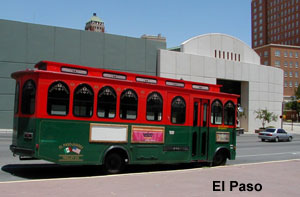
I took a shuttle bus, which in
45 minutes travelled through the town and its adjoining parks.
The bus passed by rodeo ground and the guide told in long
rambling narrative about a grand parade being held in February
each year. It was said to the world’s longest non-mechanized
parade consisting of buggies, carts, wagons, buckboards and
stagecoaches.
EL PASO, TX
In about six hours and covering
an area of 385 kms, I reached El Paso, Texas. Though real
Texas was long away, I felt uneasy. I had read warnings like
"Don't mess with Texas", "South Texas-where
everything sticks, stings or sucks," and "This is
the place your mother warned you about".
It was 5:30 AM, too early to
check in. To while away time, I went to the Food Counters and
ordered for veggie food: soap, salad and sandwich. After
having a hearty breakfast, I consulted the Information Centre
and contacted Motel Gateway. I was asked to come straight to
Stanton Road though it was still early to check-in. Later, I
learned that all motels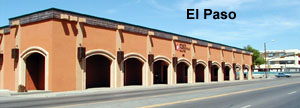 in that region offer ‘come early & stay late’
facilities.
in that region offer ‘come early & stay late’
facilities.
El Paso was a dry, sunny and
warm city. It sprawled across desert and rambling foothills. A
walk in the town would show that it had a blend of Red Indian,
Spanish and Mexican culture. It looked like a settlement of
legendary Spanish Monks, banditos, revolutionaries,
gunslingers, rustlers and gamblers.
"All you can eat for US$
5" was strong enough stimulus to jump at. I was doubly
rewarded as it was a Mexican Restaurant using chili in
curries. When I told the manager that I was used to chili, he
smiled and gave me a tour of the kitchen. Chilies varying from
half inch Lilliputian to 12-inch whopper were on display
graded as spicier, hotter, fiercer and tongue-blisterer. The
food was very delicious just like I used to have back at home.
El Paso was on the edge of the
US-Mexican Border. 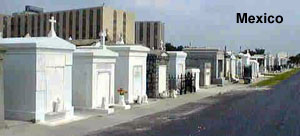 One
could walk into Mexico in about five minutes. I preferred
‘The Border Jumper’, a red and green trolley charging US $
12. After checking my visa, the Trolley Company wrapped my
left hand with a paper band signifying that I was a bona-fide
tourist. There was no visa for the border town. The trolley
crossed a bridge on Rio Grande River and rolled into Juárez
on the side of Mexico. It was like travel in a time-tunnel. I
suddenly found myself in a dirty and crowded city. Many
beggars, hookers and peddlers pestered me. Further,
shopkeepers tried hard to sell their products like leather
goods, blankets, rugs and candles. My response was straight
& simple, "No money". I returned after about six
hours to El Paso and watched TV in my room. I was amazed to
hear my country songs in ‘Punjabi’ and ‘Saraiki’ as
life history of Alexander the Great was being narrated. One
could walk into Mexico in about five minutes. I preferred
‘The Border Jumper’, a red and green trolley charging US $
12. After checking my visa, the Trolley Company wrapped my
left hand with a paper band signifying that I was a bona-fide
tourist. There was no visa for the border town. The trolley
crossed a bridge on Rio Grande River and rolled into Juárez
on the side of Mexico. It was like travel in a time-tunnel. I
suddenly found myself in a dirty and crowded city. Many
beggars, hookers and peddlers pestered me. Further,
shopkeepers tried hard to sell their products like leather
goods, blankets, rugs and candles. My response was straight
& simple, "No money". I returned after about six
hours to El Paso and watched TV in my room. I was amazed to
hear my country songs in ‘Punjabi’ and ‘Saraiki’ as
life history of Alexander the Great was being narrated.
SAN ANTONIO, TX
I spent another night in the
bus but had no loss of sleep as the bus was equipped with
reclining seats and headrests. Travelling 635 kms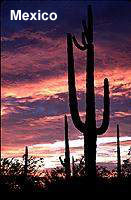 in about 11 hours, I reached San Antonio. I got a spacious
room in a motel for only $ 15 dollar. Later, a light walk in
the town revealed a strong German influence on its
architecture. There were many restaurants offering German
Cuisine and were blaring music which sounded like German –
hard-hitting. In the Centre of the downtown was a historical
site, Alamo. "Victory or Death", a battle cry, had
originated here. Hundreds of freedom fighters scarified their
lives. John Wayne, the legendary actor, was a hero in a film
based on that event.
in about 11 hours, I reached San Antonio. I got a spacious
room in a motel for only $ 15 dollar. Later, a light walk in
the town revealed a strong German influence on its
architecture. There were many restaurants offering German
Cuisine and were blaring music which sounded like German –
hard-hitting. In the Centre of the downtown was a historical
site, Alamo. "Victory or Death", a battle cry, had
originated here. Hundreds of freedom fighters scarified their
lives. John Wayne, the legendary actor, was a hero in a film
based on that event.
In the evening I went for a
River Walk on a gorgeous paved track. Being well below
street-level, it was reached by steps. Also there were river
crossings by humpbacked stone bridges. The track was more than
two miles long. Along the landscaped walkways, there were
restaurants offering ethnic foods with live music.
HOUSTON, TX
My next stop was rather near.
Houston was only 208 kms away. This was a chicken feed
considering that in Texas every thing was bigger and better.
Expressways have big sweeping interchanges, not the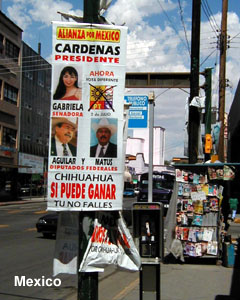 tighter ones observed elsewhere. Roads seemed to have at least
one more lane.
tighter ones observed elsewhere. Roads seemed to have at least
one more lane.
The bus passed by many ranches
having longhorn cattle and bison. In Texas, towns were either
Cow Town or Oil Town. Houston was an Oil Town. The bus drove
past miles and miles of oil refineries. Once in the city, I
took a tram tour of Johnson Space Center, which was very
informative.
NEW ORLEANS, LA
I spent yet another night
travelling to New Orleans, 393 kms away. From the bus
terminal, I contact Marquetta Hostel. I was advised to take a
taxi to reach the hostel. Standing near the terminal gate were
two cabbies, both hefty blacks called African-Americans. I
asked them, " What would be maximum charge to Marquetta
at Carondelet Street?" "Hey man, you pay by meter,
whatever it says. This is the law," they shot back. When
I insisted, they quoted $ 8. It seemed on the high side as the
hostel was not that far. I went back to free phone and told
the hotel manager about the eight bucks. "You are being
fleeced. Just wait by the Information Centre," replied
the manager and in another two minutes he arrived in his car
to pick me up. Viva la hospitality.
Called "Little
France", New Orleans had unique culture, language, food,
music and festivities. It was a Cajun country. Persecuted for
their Catholic religion, the Cajuns were first driven out of
France before settling in Louisiana. Perhaps it was this
struggle that allowed them to turn soup into gumbo, the
washboard into a musical instrument and the swamps into a
paradise. I tasted gumbo, a sort of soup thickened with file
(fee-lay), a powdered sassafras leaf, and filled with shrimps,
oysters and crabs. (Other additives could be ham, chicken,
turkey, duck and sausage as matter of choice.)
No words could be sweeter than
"Yes, you can go there by walking". It saved a lot
of money except for frequent doses of soft drinks and juices
to compensate for the sweat. I went to French Quarters which
was the oldest and most famous part of New Orleans. In about
two to three hours, I went through the area looking at
cathedrals, old type cafes, antique shops, art galleries,
pubs, historic hotels and sites like "The Haunted
House". (Legend holds that, to this day, groans and
screams invade the night air.)
New Orleans was famous for its
Mardi Gras celebration or carnival. In a museum, I saw films
and posters displaying the street parades by million masked
and frolicking participants. Another peculiarity of New
Orleans was jazz, often heralded as the only art from natives
to US. Louis Armstrong made "Dixieland" tune popular
throughout the world.
Strange but true, New Orleans
cemeteries were one of the biggest attractions. Those
"walled cities of the dead" fascinated the visitors.
The dead were buried in "tombs" above ground level.
The practice was dictated by the marshy soil. Graves would
often fill with water before they could be closed. The only
solution was to make them high enough to resist the water.
I lost track of time. Suddenly,
I found out that only one day remained out of 15 days bus
pass. My pockets also became lighter. I rushed to Jacksonville
in 14 hours, the longest bus ride ever. The bus went through
the fertile land of Alabama State. The famous movie,
"Uncle Tom’s Cabin" was based on the history of
this area. A stop at Panama City was quite rewarding. It
looked like an art town with an on-going jazz festival.
Tallahassee was next. It exemplified not only the influence of
the Red Indians, but also that of the Spanish, French and
English who occupied the area in succession. When the bus
entered Florida State, a great land diversity came into view
like marshy land, lush green forests and shimmering lakes. The
sun was rising when I reached Jacksonville. My plan to cross
the USA from south to south was complete.
RETURN TO MORE
TALES
MAIN PAGE
|